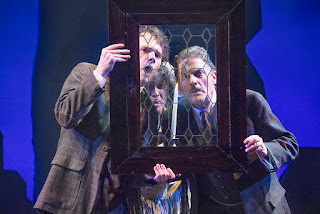The
Hound of the Baskervilles is the third of the four crime novels
written by Sir Arthur Conan Doyle featuring the detective Sherlock Holmes.
Originally serialised in The Strand Magazine from August 1901 to April
1902, it is set largely on Dartmoor in Devon in England's West Country and
tells the story of an attempted murder inspired by the legend of a fearsome, diabolical
hound of supernatural origin. Sherlock Holmes and his companion Dr. Watson
investigate the case. This was the first appearance of Holmes since his
apparent death in "The Final Problem", and the success of The
Hound of the Baskervilles led to the character's eventual revival.
One
of the most famous stories ever writte[2] in 2003, the book was
listed as number 128 of 200 on the BBC's The Big Read poll of the UK's
"best-loved novel." In 1999, it was listed as the top Holmes novel,
with a perfect rating from Sherlockian scholars of 100.
Plot
Dr. James
Mortimer asks Sherlock Holmes for advice after his friend Sir Charles
Baskerville was found dead in the park surrounding his manor, in the moors of Devonshire.
The death was attributed to a heart attack but, according to Mortimer, Sir
Charles's face retained an expression of horror and not far from the corpse the
footprints of a gigantic hound were clearly visible. According to an old
legend, a curse runs in the Baskerville family since the time of the English
Civil War, when a Sir Hugo Baskerville abducted and murdered a woman in the mires
of Dartmoor, only to be killed in turn by a huge demonic hound. Allegedly the
same creature has been haunting the place ever since, causing the premature
death of many Baskerville heirs. Sir Charles believed in the plague of the
hound and so does Mr. Mortimer, who now fears for the next in line Sir Henry
Baskerville.
Even
though he dismisses the whole curse story as nonsense, Holmes agrees to meet
Sir Henry in London as soon as the latter arrives from Canada, where his branch
of the family had moved in the past. The man is a young and jovial good-looking
fellow, skeptical toward the grim legend and eager to take possession of
Baskerville Hall, even if he's just found an anonymous note in the mail,
warning him to stay away from the moor. When someone tries to shoot Sir Henry
while he's walking down a street, however, Holmes asks Watson to go with the
young man and Mortimer to Dartmooor, in order to protect Sir Henry and search
for any clue about who's menacing his life.
The
trio arrives to Baskerville Hall, an old and imposing manor in the middle of a
vast park, managed by a butler and his wife the housekeeper. The estate is
surrounded by the moor and borders the Grimpen Mire, where animals and humans
can sink to death in quicksand. The news that a convict has escaped from the
local penitentiary and is hiding on the nearby hills, add up to the barren
landscape and the gloomy atmosphere.
Inexplicable
events happen during the first night, keeping the guests awake and only in the
daylight Watson and Sir Henry can relax while exploring the neighborhood and
meet the scarce but peculiar residents of Dartmoor. Watson keeps on searching
for any lead to the identity of whoever's attempting to Sir Henry's life and
faithfully wires the details of his investigation to Holmes. Among the others
stand out the Stapletons, brother and sister; the man is overfriendly and a bit
too curious toward the newly arrived, while the woman, a rare beauty, seems all
too weary of the place.
Distant
howls and strange sightings trouble Watson during his long walks on the hills,
and his mood gets no better even inside Baskerville Hall. The doctor grows
suspicious of the butler, who at night acts like he was signaling to someone in
the moor with a candle from a window of the house. In the meantime Sir Henry is
drawn to Ms. Stapleton, who seems to be afraid of her brother's opinion on the
matter. To make the puzzle more complex there are Mr. Mortimer, maybe too eager
to convince Sir Henry that the curse is real, an old and grumpy neighbour, who
likes to pry with his telescope into other people's houses, a beautiful woman
with unclear ties to Sir Charles and even a bearded man roaming free in the
hills and apparently hiding on a tor where ancient tombs have been excavated by
Mr. Stapleton for unclear purpose.
For
all the good Watson's efforts, it will be Sherlock Holmes in person to connect
all the clues and solve the mystery, but not before the spectral hound kills
again. In the end, Detective Holmes reveals Mr. Stapleton to actually be Rodger
Baskerville, a relative of Sir Henry's who wanted to inherit the fortune. The
hound is proved to be real, but simply a regular dog with a phosphorus-lined
mouth. Unfortunately, Holmes has to kill it to save Sir Henry.



















No comments:
Post a Comment